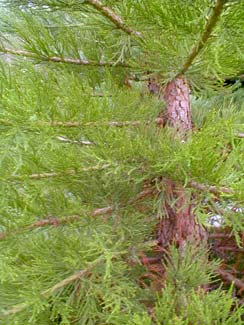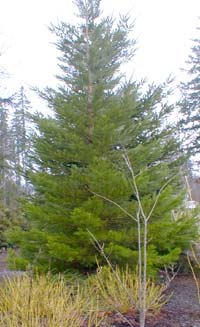
Giant Sequoia; aka,
Sierra Redwood
"A hypocrite is the kind of politician who would cut down a redwood tree, then mount the stump & make a speech for conservation."
-Adlai Stevenson
(1900-1965)
"If you've seen one redwood tree, you've seen them all."
-Ronald Reagan
(1911-2004)
(1900-1965)
(1911-2004)
The single largest tree standing in the world today -- indeed, it is has been suggested that it may be the largest living thing in the world -- is the General Sherman Tree, a giant sequoia in Kings Canyon National Park, California.
It stands 275 feet tall, with a diameter at the base of 30 feet. Trunk volume has been estimated at 52,500 feet, & it is no less than 2,200 years old, perhaps older. Although it is the largest tree overall, if height alone were considered without assessing bulk & width, there are other sequoias, plus redwoods & Douglas-firs, that exceed it in height.
Older, larger trees did once exist in great numbers in the sequoia's native Sierra Nevada Mountains. A few felled trees were measured at over 3,000 years old. Only America's Great Basin Bristlecone Pine (Pinus longaeva) & South America's Alerce Tree (Fitzroya cupressoides) are longer lived.
Loggers would have eradicated the sequoia & it would now be extinct except for one "problem" that made them unharvestable. They were so large & so heavy at over two & a half million pounds each, when early loggers cut them down, they burst into splinters upon crashing onto the ground.
 Intentional preservation did not begin until 1864 when Abraham Lincoln & the state of California arranged to protect the Mariposa Big Tree Grove, which region later became the centerpiece for today's Yosemite National Park.
Intentional preservation did not begin until 1864 when Abraham Lincoln & the state of California arranged to protect the Mariposa Big Tree Grove, which region later became the centerpiece for today's Yosemite National Park.Prehistorically the Sequoia & similar giants had a world-wide distribution & shared the earth with dinosaurs. It is today native to only about seventy-five island-like zones in California's Sierra Nevada Mountains.
They are speed-growers, young trees exceeding two feet of growth per year. Given their eventual size, they are not generally appropriate for gardens, although their buttrussed-trunk habit & taproot makes it uncommon for sequoias to fall in a storm, so not the great threat to nearby structures that a Douglas-fir can be.
A friend's estate where I do occasional landscaping does have room for giants, & no worry that the next generation will have to cut down the sequoia that greets us at the head of the lane. This one was planted as a sapling a very few years ago. By the time I was doing the gardening beginning about 2004/5, it had already grown so much that it was enveloping a nearby Coralbark Maple, which with great toil & anguish we successfully moved, since it would have been completely enveloped in a couple more years. There are several yellowtwig dogwoods near the sequoia, & one of these had to be dug up & moved the same time as the Coralbark, as it was completely hidden amidst the lower limbs of the sequoia.
Young sequoias are pyramidal with branches that start right near the ground, though old ones are rounded at the top. At a century of age they are already naked-trunked for a hundred feet, but in cultivation they tend to be only sixty to a hundred feet tall & retain their lower branches.
 Chief Sequoia, shown in the photo at the left, was the inventor of the Cherokee alphabet, & the man for whom this genus was named.
Chief Sequoia, shown in the photo at the left, was the inventor of the Cherokee alphabet, & the man for whom this genus was named.He was born about 1770 in eastern Tennessee. He was able to establish a Cherokee Nation in northern Arkansas after struggles & treaties with the United States government. In 1843 he led an expedition into northern Mexico hoping to locate a long lost band of Cherokee in order to bring them to the Cherokee Nation, but he died on that expedition.
Not long after, in 1847, Austrian botanist Stephan Endlicher assigned the Sierra redwood & the Coastal Redwood their own genus, naming them after the Cherokee chief. Then in 1854, Illinois botanist separated the two redwood giants each into its own genus, Sequoia sempervirens for the coastal redwood, & Sequoiadendron giganteum for the Sierra redwood. Taxonomists still sometimes argue whether they should have remained in the same genus.
Burls & roots of the Coastal Redwood will sprout little trees, but the Giant Sequoia does not do this. Saplings like partial shade but after reaching any height it is a full-sun tree. It likes temperate, moist climates, humid most of the year & dry in summer, so it does really well in the Pacific Northwest coastal region. It is in general more adaptable outside its native range than either the Douglas-fir or the California Redwood, making it a popular giant for the American Northeast & Europe in addition to here along the west coast.